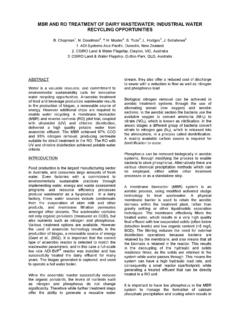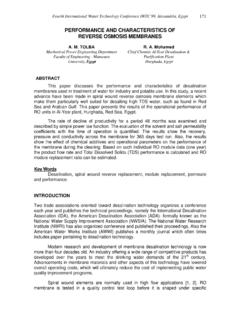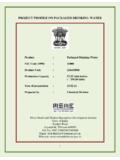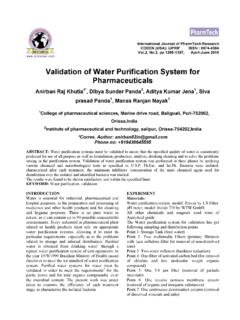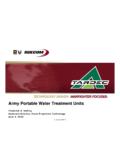Transcription of INSTALLATION & SERVICE MANUAL - Reverse …
1 INSTALLATION & SERVICE MANUAL Reverse osmosis + DI water Systems Model: RD-102 6- stage RO+DI system , 100 GPD, single output RD-106 6- stage RO+DI system , 100 GPD, dual outputs + tank+ faucet 2 PRODUCT SPECIFICATION 6- stage Reverse osmosis + DI water Purification Systems Model no: RD-102 and RD-106 Capacity: Generates 50 to 100 gallons per day depends on water temperature, pressure, chemistry variations) system includes RO+DI unit: 6- stage unit, all filters included. Storage Tank (for RD-106 only): 4 gal. pressurized tank with pre-charge pressure of 7~10 psi., powder coated steel construction with Food Grade butyl water bladder. NSF listed water Dispensing Faucet (for RD-106 only): lead-free, long reach goose neck type, chrome steel, locking lever for continuous dispensing.
2 Hardware: feed water adapter, feed water valve, drain saddle valve, tank valve, and screws. INSTALLATION & SERVICE MANUAL system Requirements Working pressure: 40 to 80 psi feed water pressure required, if below 40 psi, a booster pump is needed. We have a RO system with booster pump assembly. If the input pressure is above 80 psi, you MUST put a pressure regulator to reduce the pressure below 80 psi. Working temperature: 100 ~ 40 deg. F ( 37 ~ 4 deg. C ) pH range: 2-11 If feed water has hardness level above 300 ppm, we recommend putting a water softener prior to the RO system . If feed water has iron, rust problem, we recommend putting a iron filter prior to the RO system . If feed water has bacteria problem, we recommend putting an ultra violet sterilizing system prior to RO system .
3 Filter SERVICE Life 1st stage Sediment filter: Recommend changing every 6 ~12 months. Replacement filter Part no. 201 2nd stage Carbon block filter: Recommend changing every 6 ~12 months. Replacement filter Part no. 205 3rd stage Carbon block filter: Recommend changing every 6 ~12 months. Replacement filter Part no. 205 4th stage TFC/TFM membrane: Recommend changing every 2~3 years. Replacement filter Part no. 399 5th stage Inline carbon filter: Recommend changing every 6 ~12 months. Replacement filter Part no. 213 The filters & membrane used are all standard sizes. Dimension RO unit: Length 15 inch, Width 5 inch, Height 16 inch Storage tank: Diameter 10 inch, Height 15 inch (for RD-106 only) Faucet: 9 inch above counter top (for RD-106 only) Warranty 1 years Limited Warranty on parts, components.
4 Filters are not under warranty. Performance Average Rejection rate: 92 to 98% of dissolved solids after RO, 98% to 100% rejection rate after RO+DI Purification Processes/ Filter specifications Removes microbiological contaminants like Cysts (protozoan), inorganic/Radiological contaminants like Barium, Cadmium, Copper, Chromium (hexvavalent), Chromim (trivalent), Fluoride, Lead, Radium 226/228, Selenium, etc. Ammonia, Arsenic, chloramines, chlorine, copper, lead, nitrate, phosphate, silica, hardness, calcium, magnesium, other dissolved solids. 1st stage : 5 micron sediment filter, 2 3/4 . x 9 7/8 height, made by 100% pure polypropylene fibers 2nd & 3rd stage : carbon filter, 2 3/4 x 9 height, composed of high-performance coconut shell carbon. 4th stage : TFC/TFM type membrane, 100 GPD, 1 x 11 long 5th stage : DI filter, deionization filter, further removing dissolved solids.
5 6th stage : Inline carbon filter (polishing filter, improves taste): 2 x 10 3 Thank you for choosing Watergeneral Reverse osmosis water Systems. You now own a superb Reverse osmosis (RO) + Deionization (DI) system that effectively reducing most contaminants, organic and inorganic compound, unwanted taste and odor from tap water . It is designed to transform your tap water into distill water . Read carefully and follow the instruction in this MANUAL before proceeding with actual INSTALLATION . Failure to do so could result in personal injury or damage to the equipment or other properties. Be sure to follow any special plumbing codes in your area. CHECK LIST: 1. Reverse osmosis +DI Unit 2. for (RD-106) which includes water storage tank, 4 gallon outside volume (holds gallons @60psi) 3. INSTALLATION kit consists tank ball valve, drain saddle valve, feed water adapter, feed water needle valve, faucet assembly(for RD-106) , tubing, tube inserts 4.
6 INSTALLATION MANUAL INSTALLATION KIT: 1. Chrome dispensing faucet (for RD-106 only) 2. Tank ball valve or On/Off valve 3. Drain saddle clamp 4. tubing 5. Bottom filter housing wrench 6. tube insert * 7. feed water adapter 8. chrome ball valve for water supply * NOTE: Item #6 tube inserts are not required in the INSTALLATION , but you can put them in three places; (1) tubing connection at 1st stage filter, (2) tubing connection at tank ball valve, (3) tubing connection at dispensing faucet. RECOMMENDED TOOLS LIST Variable speed drill 1/8 , 7/16 , , and 5/8 drill bit 5/8, 9/16 open-end wrench, or adjustable wrench, pliers Phillips screwdriver Utility knife, or scissor Teflon tape OPERATING PARAMETER Working pressure: 40 to 80 psi feed water pressure required.
7 If input pressure is below 40 psi, a booster pump or a permeate pump is needed. We have a RO system with built-in permeate pumps, and we also carry booster pumps. If the input water pressure is above 80 psi (you must use a pressure regulator to step down the pressure). We also carry small pressure regulators just for the RO system . Working temperature: 100 ~ 40 deg. F ( 37 ~ 4 deg. C ) If feed water has hardness level above 300 ppm, we recommend putting a water softener prior to the RO system . If feed water has iron, rust problem, we recommend putting an iron filter prior to the RO system . If feed water has bacteria problem, we recommend putting an ultra violet sterilizing system prior to RO system . WARNING: Do not use this RO+DI system alone to treat water with bacteria problem or water source with unknown quality.
8 WARNING: Do not connect HOT water source to this unit. WARNING: Incorrect INSTALLATION will VOID the warranty. WARNING: Input pressure must not exceed 80 psi. Pressure regulator must be installed to reduce pressure. WARNING: Using other brand of replacement filters and parts will void the warranty. 4 About the system Reverse osmosis process is a separation process. Tap water enters the system , and it is separated at the 4th stage membrane filter. One side would go to the storage tank (purified water ); the other side carrying all the minerals is purged to the drain. The ratio of purified water to drain water is 1:3. That means for every gallon of water you use, it will drain 3 to 4 gallons. The drain is required for the RO process to work. If the drain is intentionally shut off, all the minerals will be accumulated inside the membrane, and it would permanently damaged the membrane filter.
9 All Reverse osmosis units require purging of water when it s producing water . Production rate: The system uses a 100 GPD (gallons per day) RO membrane. The actual production rate will depend on water input pressure, temperature, and water chemistry. At optimal condition the membrane will make 110 GPD, but on average, it would make about 60 to 70 gallons per day, or about to gallons per hour, or about 160 to 180 mL per minute. Drain rate: The drain rate of the system is set at 600 mL/min. using a flow restrictor. This drain rate is constant, independent of input pressure. If the input water supply is very hard (> 17 grains) or the TDS reading is above 600 ppm, it would be advantageous to change the flow restrictor to 800 or 850 mL/min. or change the membrane to 50 GPD to 75 GPD, in order to get better rejection and prolong the life of the membrane filter.
10 Design consideration RD-102 This system is designed to minimize the mineral content of tap water by using both Reverse osmosis process and De-ionization process. Tap water enters the system , and at 4th stage the membrane rejects about 90% to 95% of minerals to the drain. Then the mineral content is further reduced by a series of two DI filters. RD-106 This system is designed to provide 2 outputs; one for drinking water (RO) output, the other for DI water output. Tap water enters the system through the first three filters, and then at 4th stage the membrane rejects about 90% to 95% of minerals to the drain. Then the purified water (RO) water is stored in the pressure tank. When the output for the drinking water faucet is turned on, the RO water goes out of the pressure tank, and then it goes through the 6th stage inline carbon filter to improve the taste of water , and this is for drinking water .



